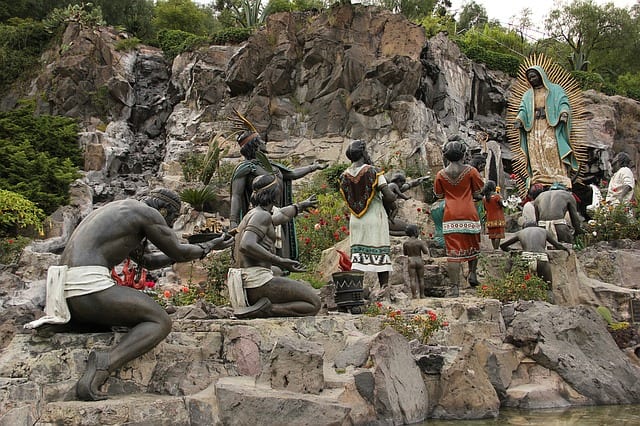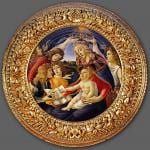
I remember a wonderful painting teacher I had one summer at Franciscan University, the year I was pregnant with Rose.
He was originally from China. He once smiled blissfully when someone wanted to paint a dragon and a phoenix. He waxed eloquent about Chinese symbolism of the male and female, the significance of the red wedding gown, and the delicious symbolic food served at a Chinese wedding party. Then the subject turned to Kwan Yin, the Chinese goddess of mercy. “I love Kwan Yin,” said the devout Catholic who started every class with the sign of the cross and a prayer for his students. “I love her because I can tell people who love her who she really is. She’s Mary!”
No one thought of this as idolatry.
An icon is a window that draws the devotee’s attention to Heaven. For this teacher, Kwan Yin was an icon.
Later that semester, a young Caucasian man said he wanted to paint an image of the Virgin Mary. He’d already painted a riotously colorful abstractified lion, which he said was a symbol of Christ. He selected an Old Master out of a coffee table art book and copied it, adding his own style and a lot of flourishes. The finished piece was not at all like an Old Master or any other painting of Mary I’ve never seen before. It portrayed a Caucasian woman cradling a Caucasian baby, their clothing a patchwork of bright and colorful streaks.
“What led you to choose this subject?” asked the teacher as he photographed it for the young man’s portfolio.
“I guess because I’ve always wanted a mother,” said the young man, and then burst into tears.
I don’t think anyone would think of that as idolatry. It was clearly this man’s icon.
In December of 1531, an indigenous man in Mexico reported that he saw a beautiful lady with gray-brown skin like his, dressed in the garb of an Aztec princess and not a Spanish one. She wore a traditional black belt around her waist, an Aztec symbol of pregnancy, and she was surrounded by pagan symbols in submission to her– she stood on the moon and eclipsed the sun. She was standing at the site of a destroyed temple to a particularly ugly Aztec goddess and asking that a church be built in her honor to replace it so that she could minister to the suffering of the Aztec people.
I don’t think many of my readers would consider her icon and all the devotion to it over the centuries idolatry, even though it probably bemused many contemporary Spanish Catholics.
In 1858, a French girl who was a terrible student and failing her Catechism classes saw a beautiful woman in a nasty old cave that was used for burning garbage. The woman did not speak to the girl in proper French most of the time, but in her regional dialect which was considered dirty and low class. She told the girl to dig in the mud of the cave until a spring of water gushed out, which sounds like something a witch in a fairy tale would do. People thought that girl was sacrilegious and insane.
I have a bottle of water from that apparition in my icon corner. I sip it for stomach aches from time to time.
I don’t think any devout Catholics of my day would call my devotion to the beautiful woman who spoke a dialect and made clean water appear in a garbage dump as if by magic, idolatry.
Here’s a song I sing to Mother Mary when I can’t think of any words to pray to her:
You can call that idolatry if you like.
To me it’s an icon, calling me to offer my sorrows to Heaven.
This year, during the Amazon Synod which was roundly mocked in the most disgustingly racist terms by certain conservative American Catholics, icons were brought to the Vatican portraying a pregnant indigenous woman. The woman’s cheeks were painted with indigenous makeup, and she was naked as women often go naked in that culture. Most people thought the image was supposed to represent Our Lady, but some said it was actually an indigenous goddess. Everyone agreed that it was a symbol of fertility and life, just as the Blessed Virgin Mary has always been honored as the vessel from which our Life came into the earth.
The Pope blessed the statues.
The same people who are always calumniating the Pope despised him for that as well. There was talk of a pagan infiltration of the Church, as if the Church wasn’t supposed to be God’s own infiltration of the pagan Roman Empire and of all the rest of the world as well. The Church is Universal. She is meant to embrace all people and gather everything into one baptism– not taking away their cultures but bringing all of their longings to fulfillment in Christ in whom there is no East or West. Not taking away their cultural experience but making everything that is good into an icon. When she doesn’t get in the way of the Holy Ghost, the Church does this. Plenty of times in history, we Catholics have chosen to mock and destroy instead of embracing and baptizing, but that’s our grievous sin.
And that sin was committed again last night.
Overnight, some zealous iconoclast stole the blessed statues from the Church of Santa Maria in Traspontina, and took them to a bridge near the Castel Sant’Angelo. The Castel Sant’Angelo is the tomb of the Roman emperor Hadrian, but it’s been used as a Papal castle for a very long time now. This is what the Catholic Church does: we take the things that surround us, whether they are in nature or in culture or in pagan religions, and we turn them into a part of Catholicism. We’ve done this with Roman emperors’ tombs, with the building sites of temples, with languages like Latin, with full moons and equinoxes, with plants and animals we turn into Christian symbols. We’re supposed to turn everything that isn’t an icon already into an icon, and we do it all the time.
The thief filmed himself pushing the statues off a bridge into the Tiber river– a mock lynching of an icon of a pregnant Madonna blessed by the Pope. A blasphemous mockery of the effort to build a bridge to help our brothers and sisters of all cultures cross the Tiber. A supreme act of arrogance, treating South American Catholics’ icons as garbage unworthy of European veneration.
He probably thought he was cleansing the church of idols.
As if the Virgin Mary belonged to him or was meant to be something only he and his culture could understand.
As if insisting that she belonged to him wasn’t the worst idolatry imaginable.
May God have mercy on us.
(image via Pixabay)
Steel Magnificat runs almost entirely on tips. To tip the author, visit our donate page.












